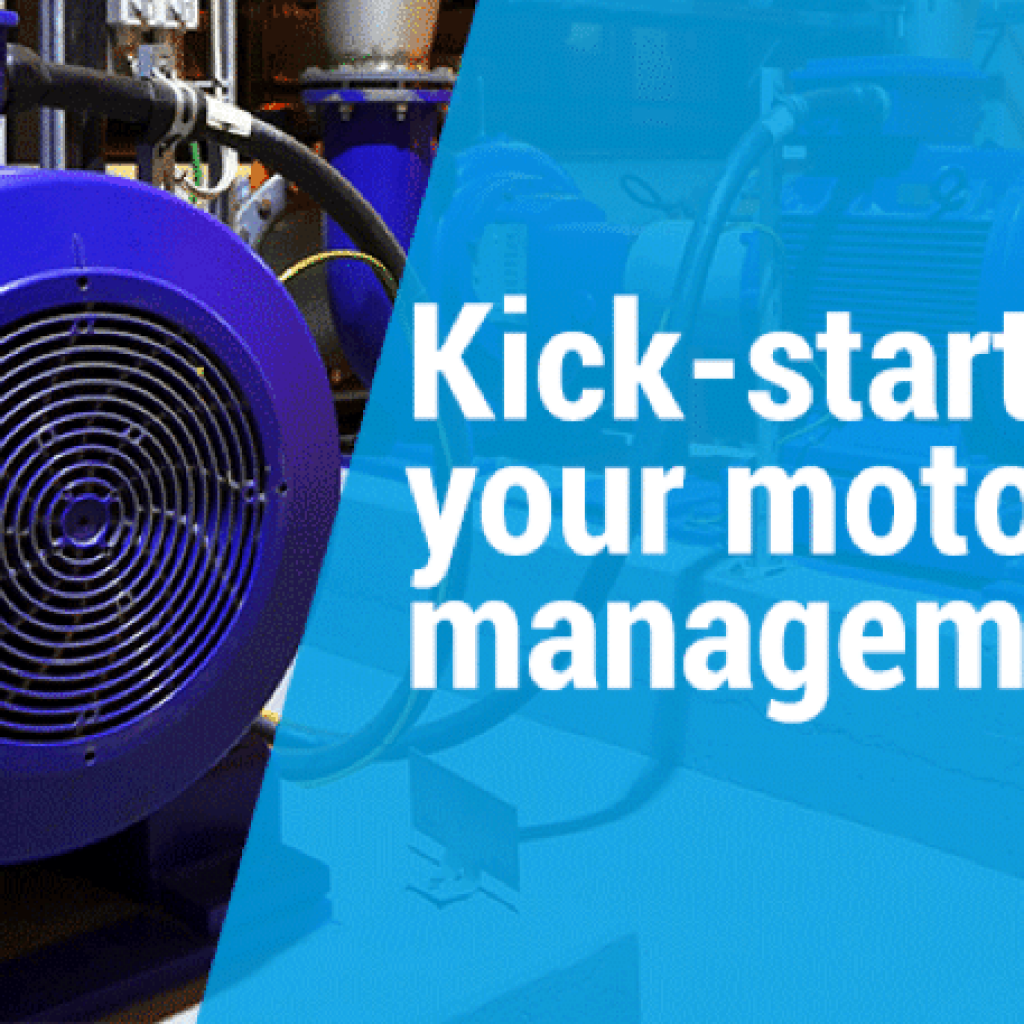Today we finish our partner spotlight on Motors At Work with another blog post by Nicole Dyess from our Partner at Motors At Work.
A motor management plan encompasses all aspects of motor ownership: Identifying the optimum motor type and size for specific operations based on load profile, duty cycles, and operating environment. Evaluating replacement opportunities and establishing repair procedures. Categorizing motors by criticality. Instituting motor purchase and repair best practices. Prioritizing maintenance procedures and determining optimal intervals.
While the plan should be flexible, it also should be tailored to the specific needs of the organization and its motor inventory. Finally, a good motor management plan helps you identify cost and energy-saving opportunities.
Organizations that have implemented motor management plans report myriad benefits, including improved motor reliability and increased uptime due to fewer motor failures. [i] When failures do occur, the motor management plan ensures you make the safest, lowest risk, and most economical motor management decision in the heat of the moment. [ii] Meanwhile, the planned availability of critical spares minimizes downtime. [iii] Furthermore, a more efficient motor portfolio uses less energy, reducing energy costs — by up to 30%. [iv]
So, what does developing a motor management plan entail? How do you get started?
While future posts will dive further into each topic, this post introduces the seven key elements of a good motor management plan:
1. Determine your motor inventory.
In my experience, most organizations do not know how many motors they have in their facilities. Even in organizations using sophisticated EAM and CMMS systems, estimates for the number of motors and total connected horsepower typically represent half to two-thirds actual. Hence, the first step in any motor management plan includes getting a handle on your motors: inventorying all motors — whether in-service or spare — and collecting nameplate data. [v]
Many EAM and CMMS systems track only basic asset specifications, such as location, installation date, and work order history. I recommend keeping full nameplate details on record, if possible, either in the EAM/CMMS system; an EAM/CMMS supplement, a solution such as Motors@Work; or a spreadsheet. Having these details makes it easier to evaluate your inventory in the subsequent steps.
2. Evaluate your repair vs. replace options.
Evaluating your options before a motor fails moves your motor management decision from panicked to planned. Starting with your most critical motors, evaluate each motor to determine the optimal response. [vi] What is the preferred replacement? How much will repairing this motor cost? Replacing it? What is the turn-around time for each option?
In addition to the outlays for a new motor or motor repair, evaluations should consider the total lifecycle cost of operating the motor, its risk of future failure and associated downtime, and availability of a spare compared to internal financial criteria, such as internal rate of return (IRR).
While EAM and CMMS systems have become nearly ubiquitous over the course of my career, I still recommend tagging critical and semi-critical motors with the outcome of this analysis so your maintenance staff can quickly see what needs to happen after these motors fail. It shortens response time, getting you back up and running sooner. [vii]
3. Manage your spares inventory.
With today’s focus on lean, many organizations keep few, if any, motor spares on-hand. [viii] Who wants an asset valued at a few hundred to several thousand dollars just sitting in inventory? However, effective spares management plays a critical role in reducing downtime. [ix]
In my experience, it’s not uncommon for firms to decide they need spares for their most critical motors after evaluating the economics of repairing vs. replacing their motors. Something about assessing the cost of each hour of downtime and receiving quotes for the cost of an expedited motor repair seems to change their mind. Thankfully, vendor services now exist that allow you to receive the benefits of on-site spares without carrying them in your inventory. If you don’t want to keep spares in your inventory, consider negotiating a consignment arrangement with your local motor dealer or retaining a spares management firm. [x]
4. Develop motor purchase specifications.
Motor purchase specifications streamline the purchasing process by identifying preferred vendors and motor specifications. [xi]
Determine the best replacement for each motor. Pay attention to specialty and non-NEMA motors: which specialty motors can be replaced, upon failure, with a general-purpose motor? Consolidating critical specifications — motor size, speed, design, frame, voltage, even grease type — in your EAM / CMMS, or a supplementary solution like Motors@Work, enables purchasing specialists to get the right replacement at the best time.
5. Establish motor repair guidelines.
Repairing a motor often degrades its efficiency; multiple studies assert motor efficiency drops 1 – 5% with each rewind. [xii] However, studies by EASA and Advanced Energy proved that motors can be up to 1% more efficient after rewind — but only if the repair shop follows certain best practices, documented in ANSI/EASA Standard AR100. [xiii]
To ensure every repaired motor retains or improves its efficiency, adopt AR100 as the standard for in-house repairs; or, if you outsource motor repairs, identify and develop relationships with an EASA-accredited shop. If you think your current repair shop may be EASA accredited, check out the four questions you need to ask yourself — and your preferred shop
6. Right-size your motor maintenance program.
Preventive maintenance protects your investment in your motor-driven assets by, as the name suggests, preventing motor failures. However, many motor maintenance programs use prescriptive, interval-based schedules. In reality, your motors’ maintenance intervals vary based on load, run-hours, ambient conditions, and power quality. Your prescriptive maintenance program may be, at best, unnecessary, and at worst, harmful to your motors. After all, studies show that 19% of preventive maintenance activities are unnecessary, [xiv] 25% occur too late, [xv] and 45% fail to reduce downtime. [xvi]
Review the results of any root-cause analyses performed on previously failed motors. What caused the failures? Where can we improve our maintenance program? Note that improvements to your maintenance program do not equate to increasing the frequency of interventions. After all, just as many motors fail from over-lubrication as under-lubrication. [xvii]
Consider investing in condition-monitoring systems, such as Motors@Work. Condition monitoring pays attention to the 65% of maintenance signals that go unnoticed by staff, [xviii] triggering maintenance tasks only when your motor-driven assets need attention. Studies show that traditional reactive and preventive maintenance programs cost 2x to 5x more than condition-based maintenance. [xix]
7. Track your motors’ KPIs.
Tracking motor-related key performance indicators can help you identify and fix recurring problems with particular motor applications. [xx] KPIs to track include motor run-hours, load-duration curves, mean time between motor failures, number of unscheduled outages, and duration of motor-related downtime, among others. I also recommend tracking the results of the root-cause analyses performed on your failed motors. These indicators align and feed into many organizations’ strategic objectives, such as overall equipment effectiveness, while elucidating opportunities for future improvements to your motor-driven systems.
Implementing an effective motor management plan optimizes your motor portfolio and improves productivity, improving your bottom line. For more information on starting your motor management plan, contact us at info@motorsatwork.com.
About Nicole
NICOLE DYESS
Director of Client Solutions
Nicole (Kaufman) Dyess has 20 years’ experience optimizing the performance of motor-driven systems. She began her career at Advanced Energy testing thousands of motors, consulting with motor & appliance manufacturers on their designs, and documenting motor management best practices for the US Department of Energy. Subsequently, she managed statewide energy efficiency programs at the NC Department of Commerce and then facilitated sustainability projects for the City of Raleigh. Nicole holds master’s degrees in mechanical engineering and public administration.
[1] T.A. Cook, Maintenance Efficiency Report (August 2013).
[1] https://www.copper.org/environment/sustainable-energy/electric-motors/case-studies/a6141.html
[1]https://www.advancedenergy.org/portal/mad/images/pdf_documents/MAD_Horsepower_bulletin_final.pdf
[1] http://www.maintenancetechnology.com/2002/11/managing-spare-parts/
[1] http://www.maintenancetechnology.com/2002/11/managing-spare-parts/
[1]https://www.advancedenergy.org/portal/mad/images/pdf_documents/MAD_Horsepower_bulletin_final.pdf
[1]https://www.advancedenergy.org/portal/mad/images/pdf_documents/MAD_Horsepower_bulletin_final.pdf
[1] https://www.iecex.com/dubai/speakers/Day%202C_1100-1200_John_Allen_EASA_Rewind_Study1203.pdf
[1] D. Anderson, “Reducing the cost of preventive maintenance,” Oniqua Enterprise Analytics (undated).
[1] http://www.plant-maintenance.com/articles/PMCostReduction.pdf
[1] http://www.plant-maintenance.com/articles/PMCostReduction.pdf
[1] http://heaa.org/wp-content/uploads/library/MotorMaintenanceGuide.pdf
[1] R. Rio, “Optimize Asset Performance with Industrial IoT Analytics,” ARC Research (August 2015).
[1] R. Moore, “A reliable plant is a safe plant is a cost-effective plant,” IMPACT Newsletter / Life Cycle Engineering (July 2016)





